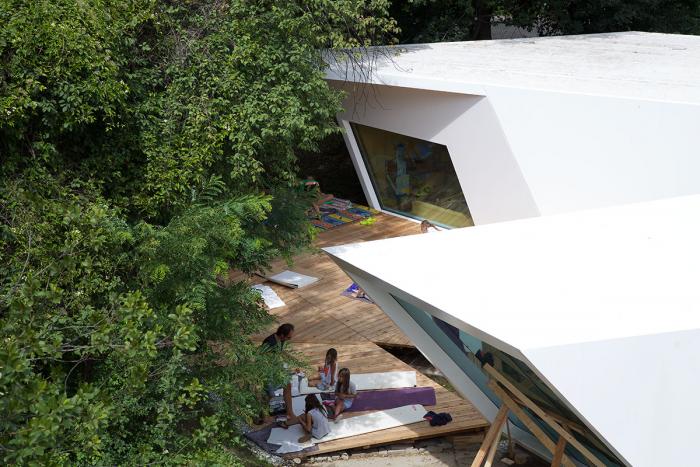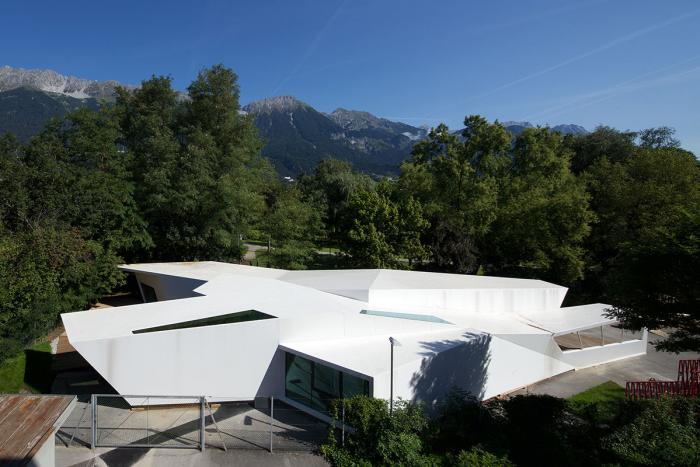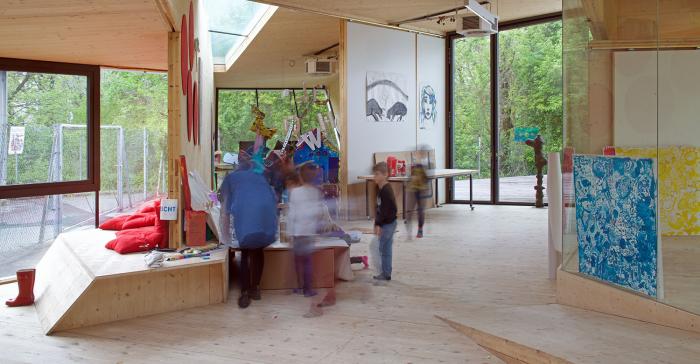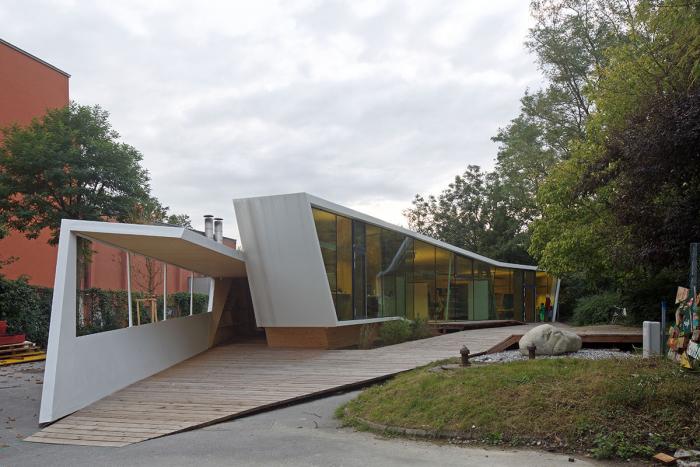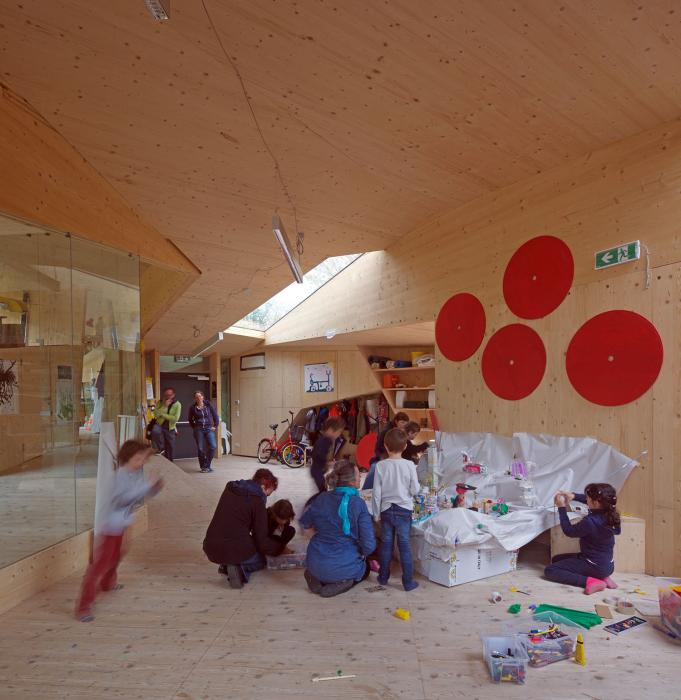I. SUMMARY INFORMATION
Project
268382
Status
Submitted
Award category
Reinvented places to meet and share
You want to submit
NEW EUROPEAN BAUHAUS AWARDS : existing completed examples
Project title
bilding
Full project title
bilding – Kunst- und Architekturwerkstatt für Kinder und Jugendliche
Description
bilding is an open space where young people from 4 to 19 years explore their own creativity, the fine arts, architecture and media, free of charge. It is an experimental space designed and constructed for young people by young students of architecture, a place for change, which sees education as “a work in progress”, where active participation, space, content and actions work together, encouraging everyone to follow their individual creativity as an important part of personal development.
Where was your project implemented in the EU?
Austria
Tirol
Amraser Strasse 5a
47.26481700806724
11.4060318009517
Innsbruck
6020
When was your project implemented?
Has your project benefited from EU programmes or funds?
No
Which programme(s) or fund(s)? Provide the name of the programme(s)/fund(s), the strand/action line as relevant and the year.
II. DESCRIPTION OF THE PROJECT
Please provide a summary of your project
bilding Kunst- und Architekturwerkstatt für Kinder und Jugendliche in Innsbruck is an institution for art and architecture for children and young adults, which is unique in Austria as well as internationally. bilding is an experimental, open space where young people are encouraged to explore their creativity, to discuss and discover architecture, painting, sculpture, design, and new media. bilding is a space for creative freedom which clearly shows in its architecture. The spatial concept and materiality create a flow in the space which opens perspectives in- as well as outwards making tangible the desire to experiment. bilding shows that creative work is all about being curious, developing questions, recognizing problems, creating constructive solutions, and allowing for multiple approaches. Thinking outside the box, communicating in a creative way, leaving one's mark, actively participating in a creative process oneself, all these things open and connect, strengthen the personality and prove to the children that they can participate in shaping their environment. Participation is free of charge and thus allows all children, regardless of social or cultural background, to participate. Approx. 225 children between the ages of 4 and 19 attend the workshops every week. In addition, bilding offers workshops and school projects all over Tyrol, creates teaching materials and organizes advanced training programmes. Based on the conceptual preparatory work of a voluntary collective of architects, architecture students from the University of Innsbruck carried out the further design work. On a site, made available by the city of Innsbruck, a privately financed pavilion-like workshop building was constructed, which also enriches the public park with its unique architecture. Designed and constructed by young people for young people, bilding is an experimental space, a place for change, which sees education as “a work in progress” and encourages everyone to actively participate.
Please give information about the key objectives of your project in terms of sustainability and how these have been met
bilding initiated a design process that was set up on a broad basis of participants from different areas.
But the road from vision to reality was a winding one.
After a few years of field research with children and young adults regarding content and location, a collective, open design process, with voluntary architects, artists, graphic designers, construction companies, and municipal and university representatives, began. Together, they formulated ideas, specified a spatial programme, and deliberated the fundamentals. In the course of numerous meetings and discussions, the location provided by the city of Innsbruck in Rapoldipark was defined as the ideal building site. As part of a bachelor thesis, the project was developed from the concrete draft, which was determined through a competition among the students, to the point of being ready for construction. Thanks to the hard work of the students, as well as the companies involved, bilding could be constructed in just under five months at a reasonable price and with simple means. It started out as a temporary project, which after six years, has turned into a permanent institution for young people.
In terms of sustainability, it was important to us from the start to consider content and realisation as an integrated whole. Location - in the midst of the city and in the midst of the park, materiality - local glued timber-laminate framework, spatial concept - combining the qualities of the location with the qualities of the new content and new building, resources - collective design with the involvement of all interested parties, children, students, lecturers, involved trades, companies, policy-makers and decision-makers in administration.
bilding was a vision that became reality and now enables future visions. A temporary facility turned into a locality for a city and its population, barrier-free, integrative, inclusive, and highly professional.
Please give information about the key objectives of your project in terms of aesthetics and quality of experience beyond functionality and how these have been met
bilding is a place for built-environment education, particularly for young people. This topic includes countless aspects ranging from scientific to emotional experiences, in technical, artistic, scientific, art-historical, anthroposophical areas, as well as the humanities. bilding itself is a one-to-one tool for conveying these complex relationships, especially when working with children and young adults.
Location, materiality, function, spatial program, orientation and content interact ingeniously and convey architecture at its highest possible quality. Children, young adults, artists, and architects alike, all feel a true sense of belonging and connection to the experimental, ambiguous but tangible and comprehensible form language of bilding. The sensitive approach to openings, transparency, retreat areas, quiet areas, connections into the park and from the park into bilding, flowing transitions of all space-forming elements such as floors, walls, and ceilings, with insights and outlooks impact and surprise all age groups beyond the forces of habit.
The overall appearance of bilding fits into its surroundings, does not assume dominance but complements and represents added value for the location as well as society.
Please give information about the key objectives of your project in terms of inclusion and how these have been met
Wanting to see, understand and grasp the “world” and actively participating in shaping it - these are essential aspects of our life, from childhood to old age. In this sense, the main objective of bilding is to offer children and young adults a suitable environment in which they can discover their own skills as early as possible and develop them further as intensively as possible. With bilding we create a space for personal development that offers children and young adults the possibility of discovering their own self as well as others. Being able to live one's own creativity, to be taken seriously with one's ideas, design wishes and fantasies and to be supported in their realization, strengthens one’s personality and self-confidence, releases constructive forces and leads to a respectful coexistence. The potential of children and young adults is their creativity, an asset stemming from nature rather than nurture. Artists, architects, and young people work together as equals, learn with and from one another, thus creating a creative and inclusive environment.
bilding offers a continuous, progressive workshop programme where artists and architects accompany and support children and young adults in developing and expanding their own personal artistic interests and talents. The aim is to encourage imagination and self-expression, to learn trust in one’s own abilities and skills, as well as appreciating foreign cultures and developing mutual respect. Participation is free of charge and thus gives all children, regardless of social or cultural background, access to art, architecture, design, and film as well as to individual creativity.
Please give information on the results/impacts achieved by your project in relation to the category you apply for
Originally the bilding building site was a place avoided by the general public, littered, abandoned and isolated, an unattractive “non-place” within the city. With the construction of bilding, we brought this neglected place back out of the shadows and turned it into an appreciated part of the park. Accessible to everyone, barrier-free and naturally interlinked with the park it feels like an extension of this public recreation area, revitalized by the content and serving the public good. The respectful treatment of this new place proves us right. Although the entire area around bilding is freely accessible and can be used by anyone at any time, there is neither littering nor vandalism. The entire area is now a new meeting point for people of all ages. An open house, bilding acts as a common area bringing together various groups of creative professionals with a creatively interested audience and offers an opportunity of working together. bilding absorbs the cultural and social diversity of the city park and incorporates it into the program as a high-quality prerequisite for artistic production. Because all children and young adults can participate free of charge, everybody can take advantage of bilding’s offers, thus paving the way for integrative and inclusive experiences for all and creating a respectful environment which encourages intercultural relationships. Due to its location in public space, bilding can work beyond its spatial limits. It offers insights and motivates to discuss and develop our common surroundings. Art and culture are essential components of a functioning society capable of development. Where there is no common language, the creative design process takes over the communication and leads to a constructive experience, which connects in a positive way and can form the basis for a mindful coexistence.
Please explain the way citizens benefiting from or affected by the project and civil society have been involved in the project and what has been the impact of this involvement on the project
In the field of visual, applied, and fine arts, bilding offers ideal support and learning opportunities, ranging from aesthetic early childhood learning for toddlers, to age-specific guidance for children and adolescents, through to supporting the creativity of young adults. This approach makes the artistic potential of young people visible, shows appreciation for their abilities while offering lasting support. For the first time, this concept also addresses the complex connection between art and architecture and thus offers an important component for the creative design of our living environment. bilding brings theory and practice into unique closeness and complements the learning opportunities offered in Innsbruck and the entire region while promoting young artistic talents. This strengthens the creative potential necessary for our society while taking the educational mandate seriously.
The name bilding stands for an open image/work of art (from the German word Bild) that combines architecture, art, education, and the state of being in process. Like building blocks, a constantly changing whole can be formed from many elementary individual parts.
Participation is free of charge and thus gives all children, regardless of social or cultural background, access to art, architecture, design, and film as well as to individual creativity.
From the very beginning, the civil society was involved in a variety of ways. Children, young adults, pupils, students, teachers, representatives from politics, administration, education, architecture, companies, passers-by, and many more were actively involved in the design process in various ways.
To this day, individual players from all areas are still actively involved in bilding. The children who were on-site during the construction have stayed with us over the years, students are now involved in the workshop program, companies regularly support the institution with materials, etc.
Please highlight the innovative character of the project
bilding Kunst- und Architekturwerkstatt für Kinder und Jugendliche in Innsbruck is an institution for art and architecture for children and young adults, which is unique in Austria as well as internationally. From the beginning bilding was conceived as an integrated whole and designed and implemented accordingly. The participatory creation process also characterizes the organization and planning of bilding's programs. Aspects of city planning, architecture, construction technology, project design and implementation, education, the development of a creative free space for young people, the benefit of social inclusion, the flexible potential for development in terms of content and formats, the organization and financing, are subject areas that are frequently requested by local and international interested parties.
For many institutions of youth work, educational training, self-organized groups and individuals, cultural institutions and art associations, individual artists, and architects and for the large group of creative professionals, bilding offers an exemplary impulse with an enormously broad background in participatory design projects.
Austria has no tradition in promoting creative interests, skills, and talents in young people. bilding is the first institution dedicated to this important topic and with its program it represents a new, indispensable area of cultural education within the general educational landscape.
Cooperation projects at home, beyond regional borders, as well as international projects, form the basis of a successful network for further exchange and constant development in this area.
Please explain how the project led to results or learnings which could be transferred to other interested parties
In addition to the continuous workshop programs bilding works on the development of innovative teaching materials for schools and kindergartens, advanced training as well as further education at a university level in architecture and pedagogy. The international network, which bilding has established, works on determining the potential in the field of built environment education and creates international exchange formats, such as the regularly held symposia on built environment education for young people as part of the Architecture Biennale in Venice.
As a place for creative experimentation, bilding acts as a research laboratory for teaching and in practice, constantly developing new formats for participatory, inclusive processes and developing new communicative methods in connection with urban district development projects. By involving young people in such projects, bilding tries to expand their creative freedom in a practical, playful way and to motivate them to participate. A focus is placed on the feasibility of the young people's contributions. In the best case, their needs and ideas play an essential role in the further course of the construction project and are regarded as equivalent parameters in project-related decision-making.
bilding shows a perfect symbiosis in its architecture and content, which is comprehensible for everyone involved, both in- and outwardly. The experiences of children and young adults as well as artists and architects are incorporated into the production of a wide range of teaching materials and give third-party teachers a deeper insight into tried and tested teaching methods.
Is an evaluation report or any relevant independent evaluation source available?
No
III. UPLOAD PICTURES
IV. VALIDATION
By ticking this box, you declare that all the information provided in this form is factually correct, that the proposed project has not been proposed for the Awards more than once under the same category and that it has not been subject to any type of investigation, which could lead to a financial correction because of irregularities or fraud.
Yes
